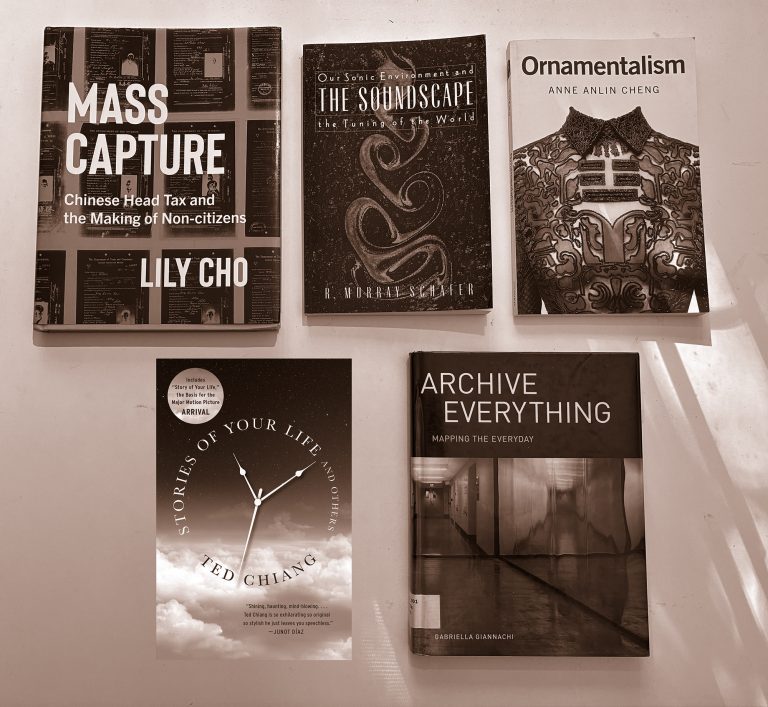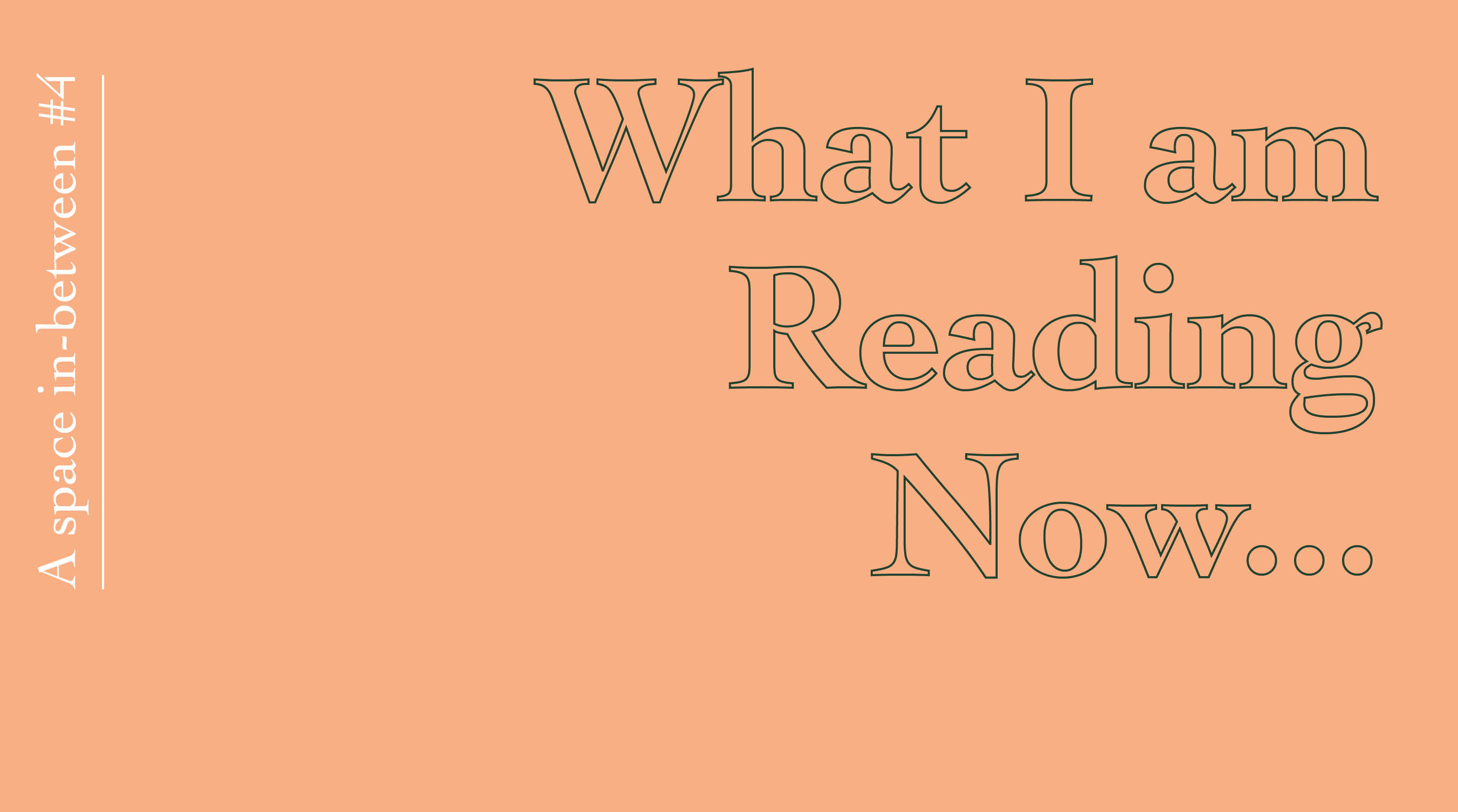What I am Reading Now…
Karen Tam 譚嘉文
August 2025
As an artist working with archival traces, diasporic material culture, and installation, I’m drawn to texts that resist fixed narratives of identity and instead consider how memory travels. The selected readings form a constellation — literary, theoretical, sonic, and cinematic — that reflects my research into how racialised bodies, spaces, and histories are mediated, silenced, or re-voiced. This shapes my approach to art-making, offering ways to think through diasporic experiences, archival gaps, and the politics of visibility.
- Lily Cho – Mass Capture: Chinese Head Tax and the Making of Non-Citizens (2021)
Lily Cho’s brilliant and groundbreaking Mass Capture, draws on 41,000 CI-9 certificates to examine the Chinese Head Tax[1] archive and unpack the systemic structures that enforced racialized visibility and mass surveillance in Canada. Cho reveals how their amalgamation of biometric data, personal histories, and portrait photographs functioned as tools of exclusion, producing one of the most extensively documented racialized communities and demonstrating how state monitoring of “others” raises vital questions and persists in modern policies. Cho’s meticulous re-digitisation transforms the archive into an act of reclamation and a rich resource for researchers.
- R. Murray Schafer – The Soundscape: Our Sonic Environment and the Tuning of the World (1977)
What does a place sound like when it remembers? R. Murray Schafer’s foundational work on acoustic ecology invites us to rethink our everyday environment through acts of considered listening. Sound holds and transmits culture, memory, and presence—especially in diasporic and displaced contexts. Where the visual archive—photographs, maps, or architectural drawings—is often fragmented or erased, historical soundscapes are elusive, unless preserved through rare recordings or ‘earwitness’ accounts. The sounds of Chinatowns, the sonic residues of place, allow me to reimagine diasporic spaces through sound.
- Anne Anlin Cheng – Ornamentalism (2019)
Ornamentalism by Anne Anlin Cheng is a feminist theory of the ‘Yellow Woman,’ through the lens of what Cheng terms ‘ornamentalism.’ Her insights have already opened up new ways of thinking for me: constructed through the decorative and the surface, the ‘Yellow Woman’ becomes a living ornament, onto which racial and aesthetic fantasies are projected. Rendering Asian women as both hyper-visible and invisible and rooted in objectification, this also become a site of resistance and agency. Cheng’s work has me reflecting on my own explorations in the aesthetics of visibility and chinoiserie.
- Gabriella Giannachi –Archive Everything: Mapping the Everyday (2016)
Who gets to tell our stories, what histories are preserved and how can art address archival gaps? I connected deeply with Gabriella Giannachi’s Archive Everything: Mapping the Everyday which reimagines contemporary archives as living, affective, and participatory spaces rooted in everyday life. Moving beyond institutional collections, she explores how artists and communities are redefining archival practices, democratising memory and reframing histories, as political and activist acts.
- Ted Chiang – Stories of Your Life and Others (2002)
I used to read a lot of sci-fi and fantasy novels when I was a teenager. After watching Arrival, Denis Villeneuve’s film adaptation of Ted Chiang’s short story, I returned to this genre. Chiang’s Stories of Your Life and Others, a collection of short stories, has lingered for how his worlds collapses the boundaries between science and speculation. They invite readers to consider how epistemologies are shaped not just by facts and technologies, but by affect and perception.
Film: Tragedy of the Emperor’s Daughter (1959), dir. Wong Tin-lam, based on the Cantonese opera 帝女花 Di Nü Hua (Princess Chang Ping)
My grandparents used to listen to and watch a lot of Cantonese opera when I was growing up — it was the soundtrack of my youth. I’m drawn to how Cantonese opera has travelled and transformed in diaspora, carried across generations in living rooms, theatres, community centres, cassette tapes, and now online streaming. It continues to hold deep emotional and cultural resonance. Exploring this form through my art practice allows me to examine diasporic sonic space, aural histories, and sonic belonging. I am taking baby steps towards an ambitious project of eventually writing a Cantonese opera. This film adaptation of Di Nü Hua (the most renown Cantonese opera since its 1957 premiere) featuring the legendary, Yam Kim-Fai and Pak Suet-Sin, has been a reference point.
[1] The Chinese head tax was a discriminatory immigration policy enacted by the Canadian government beginning in 1885, which required Chinese immigrants to pay a fee — initially $50, later rising up to $500 — to enter the country. This tax was designed to deter Chinese immigration and was part of broader exclusionary measures, culminating in the 1923 Chinese Exclusion Act, which banned nearly all forms of Chinese immigration to Canada until 1947. The policy marked a legacy of institutionalised racism, aimed at restricting and controlling the movement and settlement of Chinese people in Canada.
Karen Tam 譚嘉文 (Tiohtià:ke/Montreal, Canada) is an artist and curator exploring the constructions and imaginations of cultures and communities through her installations. Since 2000, she has exhibited her work and participated in residencies in North America, Europe, and China, including at the Victoria and Albert Museum, He Xiangning Art Museum, Montreal Museum of Fine Arts, and currently the Liverpool Biennial 2025 (until 14 September). She has received grants and fellowships from the Canada Council for the Arts, Conseil des arts du Québec, and Social Sciences and Humanities Research Council of Canada. Her recent exhibition, Swallowing Mountains, at the McCord Stewart Museum received Honourable Mention at the 2024 Canadian Museums Association Awards. Tam was the winner of the 2021 Giverny Capital Prize awarded by the Fondation Giverny pour l’art contemporain.
Tam holds an MFA in Sculpture (School of the Art Institute of Chicago) and a PhD in Cultural Studies (Goldsmiths, University of London). She is the Adjunct Curator at Griffin Art Projects and is represented by Galerie Hugues Charbonneau.
Reading
Mass Capture: Chinese Head Tax and the Making of Non-Citizens, Lily Cho (McGill-Queen’s University Press, 2021)
The Soundscape: Our Sonic Environment and the Tuning of the World, R. Murray Schafer (Destiny Books, 1977)
Ornamentalism, Anne Anlin Cheng (Oxford University Press, 2019)
Archive Everything: Mapping the Everyday, Gabriella Giannachi (MIT Press, 2016)
Stories of Your Life and Others, Ted Chiang (Picador, 2002)
Watching
Tragedy of the Emperor’s Daughter (1959), dir. Wong Tin-lam, based on the Cantonese opera 帝女花 Di Nü Hua (Princess Chang Ping)

Please note the views published in What I am Reading Now… are personal reflections of the contributors.
These may not necessarily represent the views of the University of Dundee.
Readers who wish to make a donation to support Medical Aid for Palestinians can do so here.
———
Previous Issue: Nat Raha, July 2025
Next Issue: Amal Khalaf, September 2025
